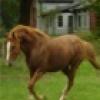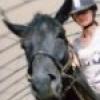Can someone explain calico genetics?
Forums
Re: Can someone explain calico genetics?
The Y chromosome contains almost no genes, because it is very, very tiny. (It is the theory held by many respected researchers that this is what makes males so deficient. :P ) The gene that Morgan is referring to is on the X chromosome and the two alleles are orange and black. If a female inherits two orange alleles, she's orange. If she inherits two black alleles, she's black. And if she inherits one of each, she is a calico/tortoiseshell. Because males have only one X chromosome, the vast majority of them can only be black or orange, not both. But occasionally, the male can experience nondisjunction of the sex chromosomes from one parent or the other (the mother gives both X's instead of just one, or the father gives an XY instead of one or the other) and the resulting offspring is XXY. These are phenotypically male because they possess the Y chromosome, but they also carry two X's and can be calico. However, the males are almost always sterile.
Re: Can someone explain calico genetics?
Are there other species where color is directly (mostly anyway) related to gender? :?
And not to muddle up this thread, but how did a black and white cat end up with a lynx point siamese? All other black and whites have tabby and tabby and white kittens. No doubt the Tom was something siamese (-ish ?) but should the dam also carry something to allow for this (cool) dillution?
Re: Can someone explain calico genetics?
I can help with Calico, Torbie and Tortie!
Tortie, is "tortoiseshell" shortened. This is a black and orange cat, usually with no white, but they can still have white spotting and be tortie. The main characteristic of "Tortie", is the cat has NO agouti. Agouti is what gives the cats their tabby stripes. Now, even in cats, agouti only affects black pigment, not red...so red cats and the red parts of a Tortie, will always show their tabby markings...but they will not have the banded 'ticking' on the hair shafts that agouti gives to the black based hairs, which give us our common striped tabby.
Torbie, is "tortoiseshell" and "tabby" combined. This just means the black and orange cat has agouti, so she will have stripes through her orange areas *and* her black areas.
Calico, is usually used to describe cats with three distinct patches of color: red, black and white, instead of the Tortie/Torbie whose black and red hairs are intermixed.
For the Meezer markings, pointed is recessive, which means the cat needs a matched PAIR (homozygous) for the pointed markings to be visible. If the cat is heterozygous it will not be pointed, but if bred with another cat who carries the recessive gene, and/or breeds with a pointed cat whose get will be assured of receiving the pointed gene, the possibility is high kittens can receive both recessive genes and be pointed. Lynx Point means the cat has inherited the pointed gene from each parent AND an agouti gene...which allows their tabby pattern to be visible.
Re: Can someone explain calico genetics?
[quote="Heidi"]I can help with Calico, Torbie and Tortie![/quote]
Great explanation. 8-) You would not happen to have pictures of each, would you? :oops:
[quote="Heidi"]For the Meezer markings, pointed is recessive, which means the cat needs a matched PAIR (homozygous) for the pointed markings to be visible. If the cat is heterozygous it will not be pointed, but if bred with another cat who carries the recessive gene, and/or breeds with a pointed cat whose get will be assured of receiving the pointed gene, the possibility is high kittens can receive both recessive genes and be pointed. Lynx Point means the cat has inherited the pointed gene from each parent AND an agouti gene...which allows their tabby pattern to be visible.[/quote]
Uhh. So a 'regular' siamese is only pointed, not pointed and tabby? :?
The kitten looks like a dillute all over. Eyes almost white, and the tabby stripes on the points are a very light beige, stuck on a cream coat.
Re: Can someone explain calico genetics?
[quote="Heather"]BTW when I worked at animal control 90% of all orange tabbys were male, we had the odd now and again female, but you could lay odds on that fact that they were most often male, and we had usually about 150 cats at a time through there.[/quote]
That's how I ended up with Tom and Gus -- both female orange cats. From a distance I assumed the orange ones were male and named them accordingly. When they were actually trapped and fixed they turned out to be females. :oops: At least I got Pepito right (male), and Benny, a black and white cat, was going to work for a male or a female (she would have been Benni). Poor Benny shunned spay/neuter day and went completely feral. Life is short and violent for a feral cat -- we just found him on the road last week at just under two years old. :(
Re: Can someone explain calico genetics?
i love calicos...we have two tabby calicos(torbie?) at the moment...and at my grandparents we always had torties, torbies and regular calicos...as well as dilute torties and dilute calicos(not sure of their real name...but instead of black they were that blue-grey and the orange was replaced by creme) as barn cats at all times (in addition to the hordes of other colors...lol)
[img]http://i84.photobucket.com/albums/k8/Po…]
the kitten we have currently...Cookie, her siblings are all brown tabby/white and a silvery grey tabby/white
don't have any real good photos of momma--Muffin. Just old ones from when she was dumped off here and this one of her crammed in where she had the kittens. Not even sure if she's a true torbie....but she's neat to look at
[img]http://i84.photobucket.com/albums/k8/Po…]
she had ear mites when she was dumped off here a couple of years ago. Some idiot poured out a 25 pound bag of cat food in the church parking lot next to us, dumped her out and drove off....
[img]http://i84.photobucket.com/albums/k8/Po…]
[img]http://i84.photobucket.com/albums/k8/Po…]
Re: Can someone explain calico genetics?
The dilute torbies are called blue and creams I believe. I have one here but don't seem to have any good pictures of her. I'll let Kasey use my camera latter today and see if she can't get some. She LOVES to take photos. She asked for a camera for her 8th birthday. Which is next week.
Re: Can someone explain calico genetics?
So my daughter's cat would be calico...
She's got orange stripes, but I don't think it's agouti? This is the only picture I have... Ying and Yang... LOL sisters that are so different and weird... Perfect for our family
[img]http://i100.photobucket.com/albums/m26/…]
Re: Can someone explain calico genetics?
[quote="vneerland"][quote="Heidi"]I can help with Calico, Torbie and Tortie![/quote]
Great explanation. 8-) You would not happen to have pictures of each, would you? :oops:
[quote="Heidi"]For the Meezer markings, pointed is recessive, which means the cat needs a matched PAIR (homozygous) for the pointed markings to be visible. If the cat is heterozygous it will not be pointed, but if bred with another cat who carries the recessive gene, and/or breeds with a pointed cat whose get will be assured of receiving the pointed gene, the possibility is high kittens can receive both recessive genes and be pointed.
Lynx Point means the cat has inherited the pointed gene from each parent AND an agouti gene...which allows their tabby pattern to be visible.[/quote]
Uhh. So a 'regular' siamese is only pointed, not pointed and tabby? :?
The kitten looks like a dillute all over. Eyes almost white, and the tabby stripes on the points are a very light beige, stuck on a cream coat.[/quote]
[i]I'll explain later, but all cats are tabbies. They require the agouti gene for the tabby pattern to be readily visible on black-based coats.[/i]
A standard Meezer (Siamese -> 'mese -> meezer) is black-based, pointed and has no agouti. If a standard Meezer has lynx-points, this means they inherrited an agouti gene and their striped tabby pattern has become visible in their darker points. Your kitten almost sounds like a very pale flame point. One with the recessive dense gene that dilutes color-coat.
In my cat book, that would be classified as a "cream point".
I think these images are a good representation of what I would call a "Calico" because they have defined splotches of black, red and white markings. Because they do not have agouti (black, w/ no stripes in the black hairs) I think they could also be called Torties, but I am not certain.
[img]http://www.hanne-mugaas.com/artblog/Cal…]
[img]http://z.about.com/d/cats/1/0/f/o/2/cle…]
This kitten is a good representation of a Tortie. She has intermingled black (no agouti) and red hairs throughout her coat.
[img]http://z.about.com/d/cats/1/7/t/o/2/cal…]
This is a dilute Tortie. They are called blue & cream. The base color is black and red, but the recessive "dense" gene dilutes the color.
[img]http://z.about.com/d/cats/1/0/5/x/muffi…]
These cats are Torbie because they have agouti; defined tabby striping in their black areas. Her tabby pattern is 'classic' or 'blotched'.
[img]http://z.about.com/d/cats/1/0/O/o/2/sum…]
This Torbie looks like one of the 'mackerel' patterns.
[img]http://z.about.com/d/cats/1/7/V/o/2/tro…]
[b]All cats are Tabby cats.[/b] Even the solid colored cats are tabby. In sideways angles you can see the different length hairs defining their tabby pattern, especially in the short hairs on the head. You can also sometimes see the body stripe pattern on their sides, in certain light or sun-faded conditions.
Cats require agouti in order for the tabby patterns ([i]classic or blotched, abyssinian all-over ticked and mackerel variations of striped, broken striped and spotted[/i]) of banded color on the hairshaft to be readily visible. Agouti only works on black bases, not red, but red cats will show their tabby pattern ([i]easier to see in short hair vs long hair[/i]) no matter what...though their red hair-shafts will not have bands of alternating color like the black-tabbies ehxibit.
Re: Can someone explain calico genetics?
I think this is interesting. One kitten has black and red with no agouti. The other kitten is black with agouti...expressing what seems to be a combination of abyssinian and striped mackerel tabby patterns.
The Calico kitty could also be called a Tortie because she has no agouti and some of her black and orange hairs are intermixed. The Calico-Tortie (Tortico? :mrgreen:) is also showing the mackerel striped pattern in her red hair. She could be called either Calico (black, red, white) or Tortie & white.
[quote="Andrea"]So my daughter's cat would be calico...
She's got orange stripes, but I don't think it's agouti? This is the only picture I have... Ying and Yang... LOL sisters that are so different and weird... Perfect for our family
[img]http://i100.photobucket.com/albums/m26/…]
Re: Can someone explain calico genetics?
I wanted to show some pics of what agouti-banding looks like in tabby cats.
Black cat, no agouti. Squirrely-Jo.
S-Jo has some wiry, white hairs intermixed into her under-coat.
[img]http://img.photobucket.com/albums/v618/…]
This is Dusty, he would have been called a "chocolate" or "cinnamon" color, I don't know which. A variation of black.
Note the difference of color-saturation on the hair-shafts showing the tabby stripes and the agouti hairs in between the stripes.
[img]http://img.photobucket.com/albums/v618/…]
[img]http://img.photobucket.com/albums/v618/…]
This is Pretty. Note the deep color-saturation in her Spotted Mackerel coat:
[img]http://img.photobucket.com/albums/v618/…]
[img]http://img.photobucket.com/albums/v618/…]
...compared to Malibu (classic) and Shasta (spotted mackerel):
[img]http://img.photobucket.com/albums/v618/…]
[img]http://img.photobucket.com/albums/v618/…]
For comparison, here are my two red cats; BooBoo and Floofy. Boo is a classic pattern and Floofy is a dilute mackerel striped pattern. Their patterns are visible in varying degrees, Floofy's longer hair and dilute color make it difficult to see his pattern compared to Boo, but the biggest difference, is comparing their non-banded hair-shafts to the black-based agouti cats' banded hair-shafts.
[img]http://img.photobucket.com/albums/v618/…]
[img]http://img.photobucket.com/albums/v618/…]
...yes, Flooter can look pink or lavender in some lights. He's a strange one.
Re: Can someone explain calico genetics?
Wow Heidi. Great info. Thank you. It is clearly visible that red does display tabby. Your first representation of a calico most certainly shows it on that leg.
I swear I have (seen) a 'pink' cat myself. When I took pictures, he all of a sudden did not seem that pink anymore, but when he first caught my eye, I swear that I had seen pink Tom. (tough enough to wear pink, I guess)
This is him, not looking too pink that day. (still some hint on the top of the back though)
[img]http://img.photobucket.com/albums/v655/…]
Mom with two babies, a tabby and her cream colored one.
[img]http://img.photobucket.com/albums/v655/…]
And the mystery baby is below. When I first saw it, it was creme, with white little feet. Now the dark(er) is filling in and the white eyes have grown the palest blue. I have no idea what it will tun into. Sorry for the bad picture. He/she was hard to 'catch' when it snapped this.
[img]http://img.photobucket.com/albums/v655/…]
Re: Can someone explain calico genetics?
so...what are cats that are black, but you move the hair (blow on it/separate it) and the part of the hair shaft closest to the cat is white....
there are a ton of these hanging around feral near where my boyfriend lives...all shorthair...look black, but if the wind is blowing hard or they are grooming themselves, you see white hair only close to the body, the black is the outside of the hair shaft furthest away from the cats body. Never seen any like this before. I managed to snag a kitten last year to double check to make sure I was seeing right, and I was. Very odd (to me anyway!)
Re: Can someone explain calico genetics?
I've been wondering about Riot, her hairs are different colors. Like, the shaft of hair changes halfway up. Dark on bottom, some are white-ish on top, usually some sort of golden. I dunno if I have a pic that shows it....it's the long sort of guard hair equivalent hairs.
http://s7.photobucket.com/albums/y291/P…" onclick="window.open(this.href);return false; has a bunch of pics
Re: Can someone explain calico genetics?
RedHayFlinger, what you describe is a "tipped" color variation, called either "smoke" or "chinchilla". They really are beautiful cats. My Flooter's fur looks similar, since his fur closest to his body is white, but I don't think he is smoke. At a Cat Forum someone has a black smoke shorthair and he looks awesome.
Google Images brought me these:
Silver Smoke cat in UK:
[img]http://animal-photography.co.uk/AP-1BTS…]
Black Smoke Maine Coon in Texas:
(not sure if WebShots allows image sharing?)
[img]http://thumb12.webshots.net/t/59/759/0/…]
[img]http://pets.webshots.com/photo/20110651…]
Black Smoke Norwegian Forest Cat:
[img]http://www.verdicatz.com/sitebuildercon…]
Re: Can someone explain calico genetics?
Riot has agouti and the mackerel tabby pattern expresses all over her coat, showing variations of striped, broken striped and spotted. She is also black and orange based, so she is calico, though with so little white and her black and red hair mixed together, I'd call her a Torbie. Tortoiseshell + Tabby = Torbie.
[img]http://i7.photobucket.com/albums/y291/P…]
The variations in her fur that you see are agouti commanding the color on the hairshaft to be segmented in a particular order to allow her pattern to mottle and blend at the same time.
Re: Can someone explain calico genetics?
Sweet! I knew she was torbie, but didn't know all the rest of that. I know nothing about cat patterns. All I know is that Riot is Torbie and Caddilac is grey and white with some weird marble-y pattern in his grey. Everyone thinks he's at least part main coone, he's softer than a persian, each hair is kinked, and he has a small mane.
also, i'm uploading some closeups of Riot that i just took, they'll be under this link:
http://s7.photobucket.com/albums/y291/P…" onclick="window.open(this.href);return false;
but it'll be a whiiiile before they are done.
Re: Can someone explain calico genetics?
This was my blue calico bobtail:
[img]http://i3.photobucket.com/albums/y87/Da…]
[img]http://i3.photobucket.com/albums/y87/Da…]
[img]http://i3.photobucket.com/albums/y87/Da…]
RIP Pearl :sad
Re: Can someone explain calico genetics?
Oh, Morgan...what a sweet, beautiful kitty-Pearl. :sad
[quote="vneerland"]
The kitten looks like a dillute all over. Eyes almost white, and the tabby stripes on the points are a very light beige, stuck on a cream coat.[/quote]
I wonder if your kitten will grow up to look like this LOLcat?
[img]http://icanhascheezburger.files.wordpre…]
Re: Can someone explain calico genetics?
[quote="Morgan"]This was my blue calico bobtail:
[img]http://i3.photobucket.com/albums/y87/Da…]
[img]http://i3.photobucket.com/albums/y87/Da…]
[img]http://i3.photobucket.com/albums/y87/Da…]
RIP Pearl :sad[/quote]
Aw... Did she hop like a bunny and walk like a stick was shoved up her @$#@$ :rofl
Phoenix does.
Re: Can someone explain calico genetics?
OMG! I just did a Google-search for chinchilla cats...
[img]http://www.sunjomar.co.za/zzz_galleries…]
[img]http://www.sunjomar.co.za/zzz_galleries…]
Re: Can someone explain calico genetics?
[quote="Heidi"][quote="vneerland"] The kitten looks like a dillute all over. Eyes almost white, and the tabby stripes on the points are a very light beige, stuck on a cream coat.[/quote]
I wonder if your kitten will grow up to look like this LOLcat?
[img]http://icanhascheezburger.files.wordpre…]
:laugh1 It would be in trouble! So far, it's an outside cat. And Texas has alarmingly little snowfall, so the camouflage part if flawed at best.
Re: Can someone explain calico genetics?
Redpoint (flame point in the states) and Cream point are different- no matter how light the Red~! Creams are dilutes while Reds are not.
Redpoint
[img]http://i21.photobucket.com/albums/b276/…]
Vneer- Post a picture of your cat please.






Re: Can someone explain calico genetics?
Calico is caused by Orange, which is on the X chromosome. In males, since they only have one X, they are automatically all orange, in females if they have Orange on one X and not Orange on the other they will be half orange. Throw in the spotting pattern and you have the three colors.